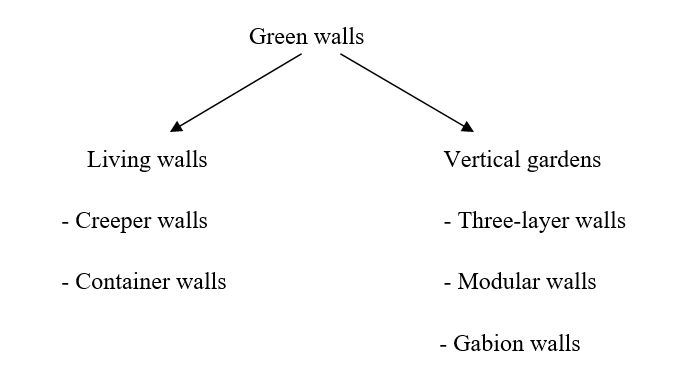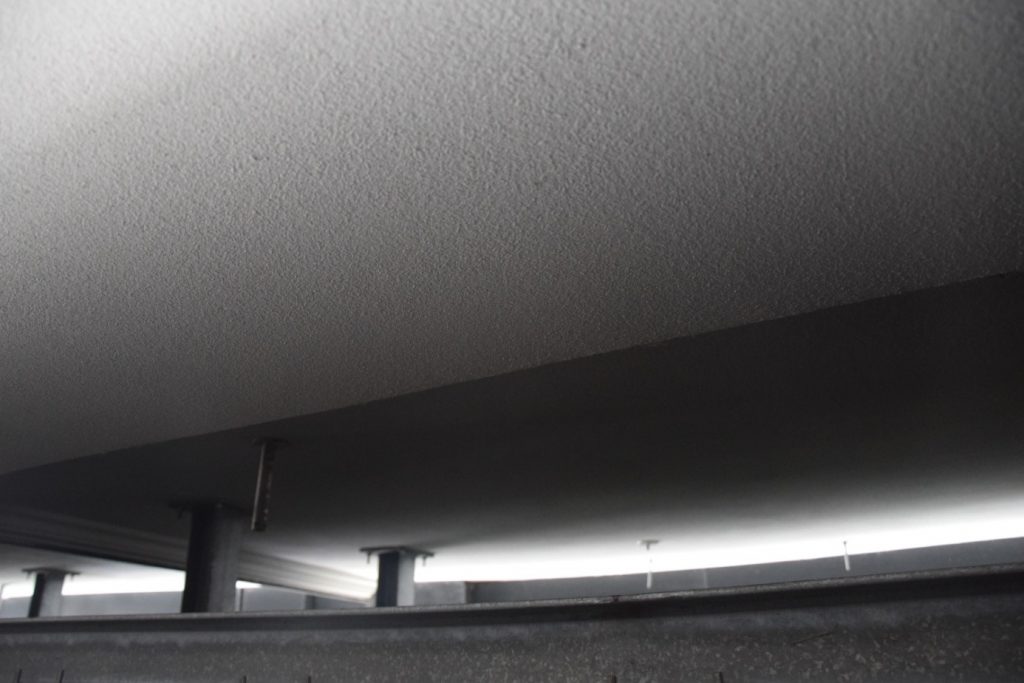Definitions
“Green walls“, “vertical gardens“, “living walls” are very diverse objects, both in technological and structural terms (varying from ones complicated and expensive to implement to ones of very simple construction, so that they can be realized independently, without too much cost). “Green walls” are used in urban spaces for greening (private and commercial) buildings, walls, engineering structures (e.g. bridges, overpasses) or as free-standing components.
“Green walls” are divided into:
“Vertical gardens” – plants do not grow naturally but are placed horizontally. They do not grow in native soil, but in purposedly designed vertical structures. The traditional substrate is replaced by the so-called filler soil substrate: a modular panel for modular walls, or a wire mesh for gabion walls. Soil substrate as the growing medium for plants can also be used in three-layer systems to fill the so-called pockets in which they grow (they can also be grown without soil – as hydroponic cultivation). Specifically designed irrigation systems are used for watering plants.
“Living walls” are systems where the plant grows vertically (roots down) or slight inclined. In the case of green walls, greened by creepers, the planting takes place in native soil at the foot of the wall or in containers placed at different heights. Another type of “living walls” are container walls, where the plants grow in separate containers installed on a structure attached to a vertical surface. The systems require or do not require purpose-designed irrigation systems.

A principal constituent of building a green wall is the plant material used to make it green. Both annuals and perennials, as well as small shrubs and trees, are used here. The selection of vegetation should take into account: economic aspects (plants should not be expensive to grow), environmental aspects (easy to grow, resistant to unfavorable environmental conditions such as drought and high solar radiation, creating habitats for urban fauna), esthetic aspects (improving the visual quality of the space concerned, creating urban interiors).
In the case of “green walls” with a large surface, the vegetation used for their greening should be “zoned” – specially selected. On the very top of the “green wall” there should be larger species, tolerant to high solar radiation and water deficits. The species planted below should be smaller in size, as well as be tolerant of shading and higher ground moisture.
“Green walls” may also be used as a place for growing edible plants – for urban farming (of salad, herbs, strawberries, tomatoes, cucumbers, etc.)
Another component fundamental for the correct functioning of the “green wall” is the drainage system – assisted by gravity. In the case of three-layer walls, it is important that the felt, being part of their construction, is uniformly watered. In modular walls, excess water from one module drains to the next module. In the case of potting systems, drainage will depend on how the individual containers housing the plants have been lined up – it may be LECA or gravel.
An integral part of building almost all types of “green walls” will be their automatic irrigation system. The system tubes might be constructed of different materials and their location and positioning density highly depend on the future irrigation intensity of the structure. Unused water is collected through a trough at the base of the “green wall” – its excess can be used to re-circulate into the system or used for watering the greenery at the foot of the green wall.
“Green walls” shall be so constructed that the excess moisture of the supporting wall (e.g. building) on which the structure is built can be ventilated and dehumidified. Environmental aspect:

Types:
Green creeper wall
Green container wall
Vertical garden in the gabion system
Vertical garden in the modular system
Vertical garden in the three-layer system
Green walls with photobioreactors with algae suspension.

Construction of green walls of the different types. Author. Agnieszka Dudzińska – Jarmolinska
Environmental aspects:
Green walls fulfil important ecosystem services[1]: they assimilate carbon dioxide, produce oxygen, purify air from particulate and gaseous pollutants, humidify and ionize air as well as produce healthy volatile compounds. They clean water, regulate air exchange and temperature, reduce noise.
They constitute habitats for animals (insects, birds and small mammals). Have a positive impact on people’s mental health (the sight of greenery, the pleasant rustle of leaves, and the seasonality of plants have a soothing effect on human well-being). They protect the building’s façade from the adverse effects of wind, rain and UV radiation. They create space (increase their esthetics, give architectural interiors a unique character), unify space (in the case of town chaos).
The role of green walls in adapting cities to climate change:
– combating the air or surfaces or pavements being heated up, reducing the urban heat island, reducing heat waves.
– combating local flooding,
– combating biodiversity loss.
Creating a network:
With green roofs, raingardens, bioswales, retention basins, green streets, community gardens.
[1] “Ecosystem services are understood to be a set of ecosystem (landscape) creations and functions that are useful to the human society (Solon 2008).” (Sudra 2015)
References:
Manso M., Castro-Gomes J., 2015, Green wall systems: A review of their characteristics, Renewable and Sustainable Energy Reviews, 41, p. 863-871
